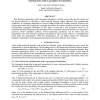Free Online Productivity Tools
i2Speak
i2Symbol
i2OCR
iTex2Img
iWeb2Print
iWeb2Shot
i2Type
iPdf2Split
iPdf2Merge
i2Bopomofo
i2Arabic
i2Style
i2Image
i2PDF
iLatex2Rtf
Sci2ools
DCC
2008
IEEE
2008
IEEE
An Estimation-Theoretic Interpretation of Video Rate Distortion Optimization with Lagrangian Formulation
Rate distortion optimization with Lagrangian formulation is widely used in video encoder control and has proved effective in achieving a good trade-off between coding efficiency and computational complexity. It is generally interpreted as a source coding problem with a fidelity criterion. However, this interpretation cannot fully explain the Lagrangian formulation for motion estimation and how to select the corresponding Lagrangian multipliers. In this paper, we provide a new perspective based on an estimation-theoretic interpretation that formulates motion estimation and mode decision as a maximum a posteriori (MAP) estimation problem. Several interesting conclusions can be drawn from this interpretation. We show that the Lagrangian formulation in video encoder control is a straightforward result under this interpretation. With this interpretation, we can further analyze the Lagrangian multiplier's dependence on the quantization parameter and motion intensity of the content.
Computer Graphics | Corresponding Lagrangian Multipliers | DCC 2008 | Lagrangian Formulation | Lagrangian Multiplier |
| Added | 25 Dec 2009 |
| Updated | 25 Dec 2009 |
| Type | Conference |
| Year | 2008 |
| Where | DCC |
| Authors | Zhen Li, Alexis Michael Tourapis |
Comments (0)

